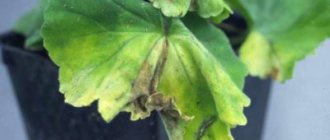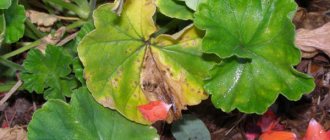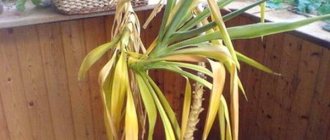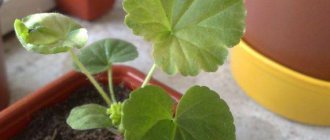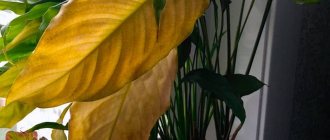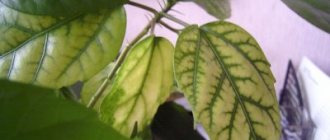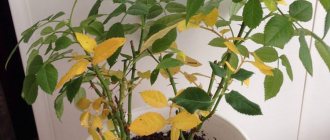Mistakes when caring for indoor geraniums
Illiterate care is the main reason for the appearance of yellow leaves in geraniums. This is an unpretentious plant to grow, but the basic rules for its development must be followed. Knowing the typical mistakes, it is easier to understand what your favorite indoor flower needs.
Wrong capacity
The choice of a pot for pelargonium must be approached very carefully. Some novice gardeners wrongly believe that the roots need a lot of space. But this is not suitable for all plants.
Indoor geranium in a tight container will quickly fill the entire space with roots and the growth of the plant will slow down. As a result, the leaves will begin to turn yellow and dry out. Using a very large flowerpot is also not an option. In a spacious pot, pelargonium will begin to intensively grow its root system, devoting all its strength to this process. For this reason, flowering will be delayed.
Over a large area there is a risk of moisture stagnation, which will lead to the development of rot.
Lack or excess lighting
Pelargonium is a light-loving flower. It is better to place it on a windowsill where there is enough light. In the shade, a yellow edging will form on the leaves and they will begin to dry out. But direct rays of the sun are also detrimental to pelargonium. They cause brown burns.
Watering too much
Indoor geranium is a drought-resistant species, this should be taken into account when caring. It is enough to water once a week. During hot summers, the frequency of moisturizing can be increased. The plant does not tolerate excess moisture. A characteristic sign is the appearance of yellowness on the foliage.
Lack of regular watering
Indoor geranium is capricious regarding watering. It does not tolerate a lack of moisture and does not respond well to waterlogging. You need to find a compromise: water the soil when it dries 2.5 cm. If this is difficult to monitor, then mulching the soil would be a good option. Pine bark, peat, crushed stone, tea, moss, and marble chips are suitable for this. The time between watering will increase, there will be no risk of rot spreading, and yellowing of the leaves will be prevented.
Incorrectly selected soil
In order for pelargonium roots to grow well, you need a special loose, fertile soil mixture. You can buy it in the store. Soil collected in the yard or forest may be unsuitable for indoor geraniums and will cause poor development and lack of flowering.
Also read the article about varieties of pelargonium and proper care for it.
Increased air humidity
Not only the root system, but also the leaves are sensitive to excess water.
Do not spray the plant with a spray bottle. This will negatively affect the color of the greens; they may turn yellow.
Heat
Indoor geranium grows best at a temperature of +20 °C. High degrees cause yellowness on the leaves. This happens especially often in winter, when heating radiators strongly heat the air near the windowsill on which the plant stands. When it gets colder, the development of pelargonium slows down and flowering is delayed. She is preparing to die.
No fertilizer
Active growth and rapid flowering require good feeding. This requires iron, phosphorus, and potassium. Nutrients must be added regularly once a month. You can buy a universal mixture for indoor flowering plants with a low nitrogen content.
We recommend reading the article about why your pelargonium may not bloom.
Herbicide ingress
When the leaves of indoor geraniums turn yellow and dry, there is a possibility that chemicals, such as weed control drugs, will come into contact with the plant. Pelargonium is sensitive to household household hygiene and cosmetic products - air fresheners, hair sprays.
Drafts
Indoor geraniums are often placed on window sills. Not surprisingly, this beautiful plant is always pleasing to the eye. But regular ventilation harms the appearance of pelargonium. The leaves begin to turn yellow and dry out, and gradually they all fall off. You can correct the situation by choosing a place without wind.
Poor or no drainage
To remove excess moisture from the root system, the pot must have a drainage layer. In its absence, the process of decay begins, which gradually destroys the entire plant. Its beginning can be determined by the leaves. They begin to turn yellow for no apparent reason.
What to do if your indoor flower is sick?
The choice of measures to combat yellowing and drying leaves depends on the causes of the problem.
- If the reason is a violation of the temperature regime, then it is important to remember the following. The most suitable temperature for geraniums during the growing season is +20-25 degrees. In winter, this figure should drop to +10 degrees.
- When leaves dry out due to improper watering, this process should be carefully monitored. If it is very hot in summer and the ground quickly becomes crusty, then the plant is watered 1-2 times a day. But this is subject to the presence of a good drainage “cushion” at the bottom of the pot. If the soil remains moist, there is no need to water as often.
Do not spray the flower with a spray bottle. This can cause yellowing of the foliage.In winter, the frequency and abundance of watering is reduced. During this period, it is important to prevent overflow or stagnation of water. There is no specific watering schedule for geraniums; it is necessary to constantly monitor the level of soil moisture.
To check the level of moisture, you can stick a wooden skewer into the ground to a depth of 12 cm. Then you need to carefully pull it out and inspect it. If the stick remains dry, then it’s time to water it.
- If a plant has been living in one pot for a long time, then perhaps it has become too small for it. You need to move the geranium to a larger “apartment” - the dried leaves will disappear.
- Often the leaves dry out due to improper feeding. Fertilizers should be applied only during the growing season (spring and summer). Complex fertilizers should contain a minimum amount of nitrogen and a maximum amount of phosphorus and potassium.
- If the cause of leaf wilting lies in disease or pest damage, then fungicides, soap solution and complex insecticides will come to the rescue. Treatment is accompanied not only by treatment, but also by the removal of affected leaves and flowers.
Diseases and pests
If, with good competent care, geranium leaves still turn yellow, then the cause may be diseases of indoor plants.
Gray rot
Pathogen: Botrytis cinerea (gray botrytis). Lives in the ground from one to two years. Spreads by wind, with soil, water, and other infected plants.
Causes:
- moisture stagnation:
- high air humidity;
- excessive spraying;
- a large amount of nitrogen in the soil;
- poor ventilation.
The disease is characterized by damage to foliage. Areas with a velvety coating and brown spots form on it. The disease affects the lower leaves most severely.
First aid: treatment with fungicides (Fundazol, Vitaros).
Rhizoctonia rot
Pathogen: Rhizoctonia solani. Infection occurs through the soil.
Causes:
- excessive amount of fertilizing;
- exceeding the permissible temperature;
- excess moisture;
- light deficiency;
- poor ventilation;
- a difference of 6...8 °C between the temperature of the soil and the surrounding air.
The disease affects the roots and stems of the plant, causing depressed spots to appear on the stem. The fungus begins to spread over them (to a height of no more than 25 cm).
First aid: stop watering and treat with fungicides (Fundazol, Vitaros, Rovral).
Alternaria blight
Pathogen: Alternaria alternata. Infection occurs through the soil, especially under greenhouse conditions (warm and humid).
The reason is high humidity.
Yellow and brown spots with a light center appear on the leaves. At high humidity they are covered with dark velvet. Most often, the disease affects zonal pelargonium.
First aid: treatment with fungicides (Skor, Ridomil Gold, Rovral).
Verticillium wilt
Pathogens: Verticillium dahliae and albo-atrum. Lives in the ground for up to 15 years. Infection occurs through damaged roots during rooting of cuttings.
The disease is especially active in summer, when the weather is warm and the soil dries quickly.
It begins with yellowing of the lower leaves. Subsequently, the disease covers the entire plant. In severe cases, you have to throw away the pelargonium along with the soil.
First aid: maintaining proper soil moisture and treating with fungicides (Fundazol, Vitaros, Rovral).
Rust
Pathogen: Puccinia pelargonii-zonalis. Transmitted through other affected plants with water and air.
The onset of the disease can be determined by brown dots on the stem. Then the leaves begin to turn yellow. Gradually they all fall off.
First aid: reducing air humidity, stopping spraying, getting rid of diseased leaves, treating with fungicides (Topaz).
If indoor geraniums turn yellow, you need to inspect the plant to see if it has been attacked by parasites. They rarely attack pelargonium, since the strong specific smell repels them.
Pelargoniums are usually plagued by whiteflies. She lives and lays larvae under the flower. If the colony of pests grows to a large size, the leaves turn yellow or turn brown. You can see the whitefly with the naked eye. It is up to 3 mm in size with white wings.
When geranium leaves begin to turn yellow and curl inward, it is an aphid infestation. It is difficult to get rid of it, but it is possible. To do this, remove all affected parts of the plant, and then treat with Fitoverm or Mospilan.
We recommend reading an article about why indoor geranium leaves can curl and dry out and what to do about it.
The plant has dried up: resuscitation at home
There are situations when the geranium has dried out completely. How to save a dried plant :
- Inspect the dried flower: if there is a living trunk left, then the geranium should be put away for the winter in a cool place. The stem may grow back in the spring.
- If the stem is dried, dig up the root and place it in water; if the root produces new roots, then plant it in the ground.
TIP : To create favorable growth factors for geranium and prevent its dryness and diseases, it is necessary to perform a set of preventive procedures.
Prevention measures:
- carry out careful timely transplantation into suitable pots;
- carry out moderate watering according to the degree of drying of the soil surface;
- establish that the geranium is located in a place protected from drafts;
- apply organic and mineral fertilizers (during the flowering period - twice a month);
- diagnose and eliminate pests;
- When yellow leaves appear, their timely removal is required.
Despite the unpretentiousness of geraniums, it takes some effort to grow beautiful, well-groomed plants. Any disease can be cured if the necessary measures are carried out correctly in time.
Plant buds can be helped to bloom. Even a dried flower can be revived . Having created the necessary conditions, the owner will be rewarded with an elegant, blooming space.
Mr. Summer resident informs: first aid for geraniums and prevention
Indoor geraniums with yellowed leaves can be saved. Tips for quickly helping pelargonium:
- when replanting, inspect the roots for rot or disease, if damaged, wash with a weak solution of potassium permanganate, and completely change the soil;
- a pot with a flower in autumn and winter is placed further from heating radiators, it can be taken out to a glazed balcony (if the temperature there does not drop below +12 °C);
- pour soft water over it, let it sit for a long time and add a pinch of citric acid or lemon juice (3-4 drops);
- constantly inspect for damage by insects and fungi, and take timely measures to get rid of them;
- the soil is chosen in the store; it is a universal soil for indoor plants;
- if the surrounding air is dry, do not moisten the pelargonium from a spray bottle; it is best to place a cup of water or wet expanded clay next to it;
- feed regularly, since the flower is sensitive to the lack of nutrients (choose complex fertilizers in the store);
- In order for pelargonium to bloom magnificently, pruning is done in the spring, leaving a few shoots;
- if the plant stretches to one side, the pot is turned to the sunny side with different sides;
- Before watering, loosen the soil; the root system of pelargonium needs oxygen;
- in winter, they carefully watch so that the leaves do not touch the cold glass, as a result they dry out, turn yellow and fall off prematurely;
- on a hot summer day on the sunny side, the window is shaded with a sheet of paper or a piece of gauze;
- if the window sill is cold in winter, to insulate the roots, place a wooden kitchen stand, a towel, and several layers of woolen fabric under the pot;
- if there is no drainage layer in the pot with geraniums, and replanting will not happen soon, then regularly pierce the ground in several places with a hot knitting needle;
- in winter, cover the batteries with a damp thick towel, this will get rid of the increased temperature in the room and too dry air for pelargonium on the windowsill;
- A good container for indoor geraniums is a ceramic pot. Porous clay allows air to pass through, excess water evaporates faster, and air flows to the root system.
Beautiful green leaves of pelargonium indicate the health of the plant and proper care. Changes in color indicate diseases, pests or bugs.
Why do geranium leaves turn yellow?
Sometimes the leaves of indoor plants begin to turn yellow and dry out. Often the provocateur is illiterate care. In this article we will look at all possible reasons and tell you what to do. But first, a few words about the plant itself.
Pelargonium, which we grow at home (mistakenly calling it geranium), is a beautiful and unpretentious indoor plant to grow. It fits perfectly into the landscape design of the garden plot, as it feels good in outdoor conditions. It is a wonderful home decoration, a bright reminder of summer. Sometimes the foliage of “geranium” turns yellow at the edges. Gradually the greenery dries, falls off, and its appearance deteriorates greatly.
If you do not take care of the flowers in a timely manner, they will die. For this reason, you need to study the standard mistakes when growing “geranium” so that it always pleases with its appearance.
Water scarcity
Signs.
The leaves of geranium have a dry yellow border of a dark, almost brown hue. Pigmentation is noticeable throughout the plant.
Solution.
Watering is discussed above. You should not rush from one extreme to another and completely dry out the earthen lump. Geranium is also a living plant and loves to eat and drink. Especially in summer and in the heat.
Don't have time to water your flower often? Place him in more reliable hands. Or change the geranium’s place of residence, where the temperature is lower. This way, the moisture from the pot will evaporate more slowly, and the roots will not absorb it at the speed of the pump.
By the way, if possible, then in the summer you can not torment the beauty with a hot window sill, but transplant it directly into open ground. Just not in direct sun. Preferably where you most often run with a watering can or watering hose. In autumn you won’t recognize your geranium. Instead of a stunted stick with yellowing, drying leaves, a beautiful powerful bush with juicy green burdocks will grow.
Just don’t plant it in the far corner of the garden or plot. You'll definitely forget.
Watering in combination with fertilizing
From spring to early summer, as well as during flowering, geraniums need fertilizer. For feeding, several means are used that will give strength to the plant and promote growth and development.
For lush flowering, fertilizing is applied along with watering.
Fertilizers for geraniums:
- Iodine. Add 1 drop of the drug to a liter of water. The geranium is first watered with plain water, then 40-50 ml of the prepared iodine solution is added to the edges of the pot.
- Ammonia. Dissolve 1 tsp in a liter of water. alcohol The day before applying fertilizer, water the flower.
- Hydrogen peroxide. Stir 2 tbsp in a liter of water. l. facilities. Water the flower with plain water, then fertilize with the solution.
- Epin. An excellent product for feeding. Dilute according to the instructions and water the flower with the solution at the root.
- Succinic acid. 1 tablet is diluted in a liter of water. Watering is done at the root. After this, it is advisable to spray the leaves again.
- Boric acid. Mix 0.5 g of product in a liter of warm water. Water at the roots. This solution can be sprayed on the foliage.
Such fertilizing is not necessary often. Once every 3 weeks is enough.
Lack of light
Signs.
The lower leaves gradually turn yellow and dry out, the stem becomes elongated, and the geranium blooms very rarely and little.
Solution.
Change your young lady's place of residence. Place it closer to the light or even add additional lighting with phytolamps. Do not touch the leaves themselves. You can pinch the crown so that the geranium grows wider. Otherwise, only a bare stem and a bunch of leaves at the top will remain.
If you already have such a “miracle”, then the best option would be cutting cuttings and rooting. Because new leaves will no longer grow on the stem.
Fungal diseases
Signs.
First, yellow spots appear on the leaves. Over time, they grow over the entire surface. Sometimes a gray or whitish coating of mold may appear. Then the leaf blades dry out. The fungus affects the entire plant.
Solution.
When the disease has just begun, treatment should be started immediately. Otherwise, it will be impossible to save the geranium later. Spray with any suitable systemic fungicide. Strictly according to the instructions and without increasing the dosage.
A small young plant can simply be dipped entirely into the medicinal solution. Most likely, it will not be possible to bathe an adult large bush. But it is necessary to spray thoroughly, until all leaf plates are completely wetted from the outside and inside. Because the fibers trap microdrops of the solution and prevent it from working directly with the green mass.
If time has already passed and the plant is completely affected (the fungus has spread to the stem), then fungicides will no longer help. Can you find shoots that are not heavily infected? Cut them off with a sterile knife or blade. Then try to root it. Couldn't find at least one healthy twig? You'll have to say goodbye to geraniums.
By the way, the soil from under it also needs to be thrown out. Before the next use, the pot must be disinfected with boiling water or a hot, strong solution of potassium permanganate.
Sunburn
Signs.
The leaf blades turn yellow and then turn white throughout the entire plant. Then they dry out.
Solution.
Geranium is of course light-loving and can easily tolerate direct sunlight. But there is a limit to everything. For example, in recent years, the summer of the middle zone has brought incredible surprises. On the windowsill the temperature can be well over +40°C. Even a cactus will wither here, let alone a geranium.
Be sure to shade the bush for the summer with white paper or a curtain made of cotton fabric. If the window design does not allow it, then simply move the pot from the windowsill to a table or bedside table near the window. There will be enough light, but there will be no burn.
How to prevent the problem?
In order to prevent the appearance of wilted leaves, you should eliminate all negative factors , re-read the basic rules for caring for geraniums, and set up an orderly schedule for watering and feeding the plant. After all, coping with diseases and their consequences is not always easy. It's better not to let this happen.
When you correctly follow the above instructions and devote more time to your favorite indoor plant, then geranium will delight you for a long time with lush, juicy foliage and bright flowers. And the aroma will calm her down and set everyone in the household positive.
If you find an error, please select a piece of text and press Ctrl+Enter.
Source
